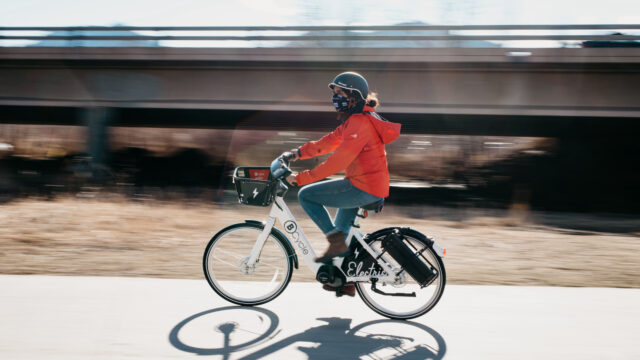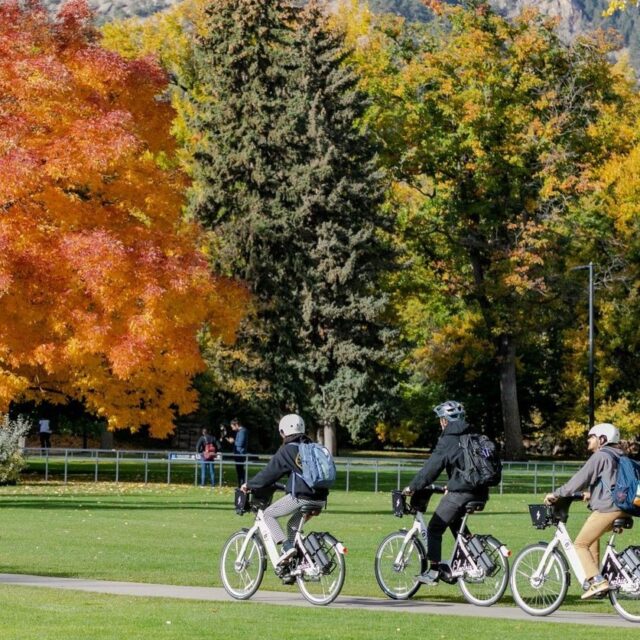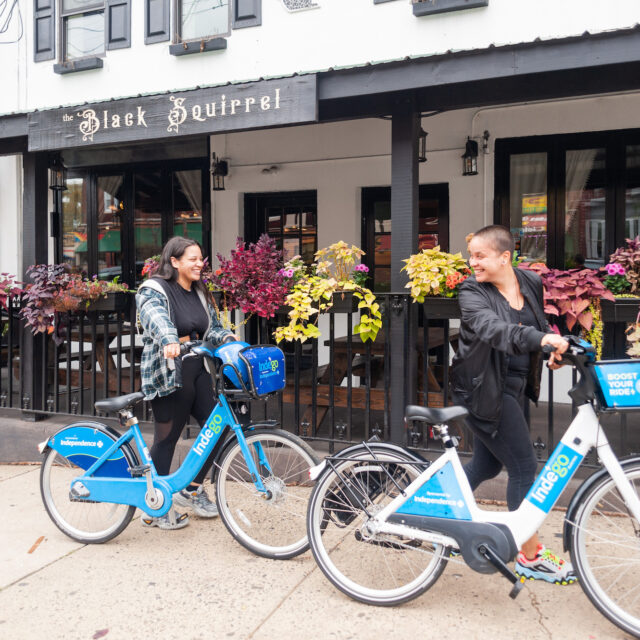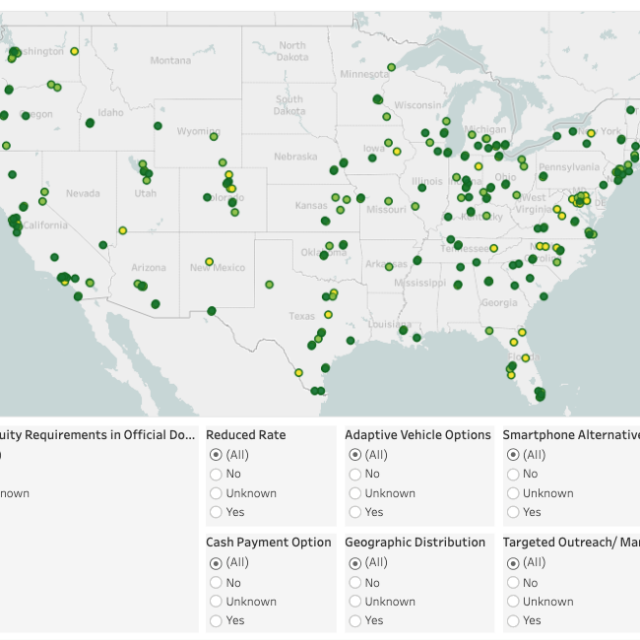Riding Around on Bike Share
by Kiran Herbert, Communications Manager
December 21, 2022
Tales from one writer’s experience using their local bike share system.

The author, riding around on a Boulder BCycle electric pedal-assist bike.
When I began working for the Better Bike Share Partnership, in January of 2021, I’d only ever used bike share once before. That experience had been seven years earlier while visiting Montreal, but it stuck with me. Having access to bike share made for an incredible visit, allowing me to tap into the pulse of the city, easily getting between my Airbnb and sites like the Botanical Garden or the Jean Talon Market. Of course, it was the early days of bike share and it wasn’t all easy: there were cobblestone streets to contend with, the difficulty of riding a heavy bike uphill, and a lot of confusion around the system’s pricing scheme.
Back in my Boulder home, using bike share had never really made much sense. Both where I lived and where I worked were outside the Boulder BCycle footprint, and transferring using transit would have turned a fifteen-minute commute into an hour. I could afford to buy my own bike, so that’s what I did.
In 2022, however, things changed. We moved offices and suddenly I was working in the heart of downtown Boulder. The change in offices came with free BCycle memberships for all company employees. I also bought a home in the foothills just outside of town, which is bikeable but only comfortably so in the summer. So I began to use bike share, driving my car five minutes and 1,000 feet down from my neighborhood to the nearest station, parking, and checking out a bike.
In many ways, it was liberating: I didn’t need to worry about using my car’s heavy bike rack, locking up my bike, or tackling a big hill on days when I didn’t feel up for it (all of the BCycle bikes are electric-assist). Within the Boulder BCycle footprint, stations are plentiful and if you’re a member, it’s a relatively affordable $150 a year for unlimited 60-minute trips (or $30/month if you’re more of a fairweather rider). Plus, BCycle’s bikes serve my shorter female frame.
Still, Boulder is plagued by many of the same issues that afflict bike share as a whole. For one thing, BCycle doesn’t offer any sort of low-income membership pricing, although it does have a library pass program (making bike share available for free to anyone with a library card) and an ongoing partnership with a few community organizations in town that serve the traditionally underserved. As Boulder is a college town, the system feels mostly designed for students, all of whom receive free memberships.
The bikes also don’t always have a charge, which is to be expected, but unlike Santa Barbara BCycle — a newer system that I got to experience while on vacation there — you can’t see how charged a bike is simply by looking in the app. When a bike is broken or won’t stay on, the ride to another station without e-assist can be grueling. The stations around my office are also constantly empty, which can make it difficult to rely on when time is at a premium. What’s been hardest, though, is my inability to trip-chain and run errands, as I never could figure out the bike’s locking mechanism and the basket is too small to accommodate much.
Despite being a “bike-friendly” town, Boulder is lacking in safe and protected on-street infrastructure. While our City Rating’s score is a respectable 66/100, among the highest in the U.S., I often find myself on “bike lanes” that are little more than paint in a car lane. In fact, the city’s newest “bike lane” is essentially a small strip of asphalt squeezed next to raised car parking. I’m often struck by how lucky I am to live in one of the best places to bike in America and yet, I still don’t feel safe doing so on a daily basis (this is true even when I don’t ride bike share, although only using the latter am I ever without my helmet).
My time using bike share has been invaluable when it comes to the work I do, as it’s offered me perspective where I was lacking. My experience is unique yet it’s also fairly typical. Bike share has changed my life for the better, allowing me to reduce my carbon footprint while making my commute more joyful. It can also sometimes be annoying, a method of transportation that’s not always reliable or practical.
In my two years of reporting for BBSP, I’ve become convinced that shared micromobility is a crucial part of the transportation landscape and that it will only continue to be with time. My research has also made me incredibly aware of the known barriers to bicycling, barriers that become even more urgent once you’re actually experiencing them. To truly transform our cities, shared micromobility needs to be seen as an integral part of our transit systems. And for widespread adoption, we need to ensure that everyone feels comfortable and safe using it.
I can’t imagine a better way than for public officials — the folks in charge of approving street designs, allocating funding, and prioritizing projects — to actually use bike share. Now that I regularly ride it, I’m a better bike share advocate, more attuned to what’s working and what we need to solve as an industry. Riding around on bike share has left me energized — I’m eager to continue working to make shared micromobility more equitable and sustainable in 2023.
The Better Bike Share Partnership is funded by The JPB Foundation as a collaboration between the City of Philadelphia, the National Association of City Transportation Officials (NACTO) and the PeopleForBikes Foundation to build equitable and replicable bike share systems. Follow us on Facebook, Twitter and Instagram or sign up for our weekly newsletter. Got a question or a story idea? Email kiran@peopleforbikes.org.



